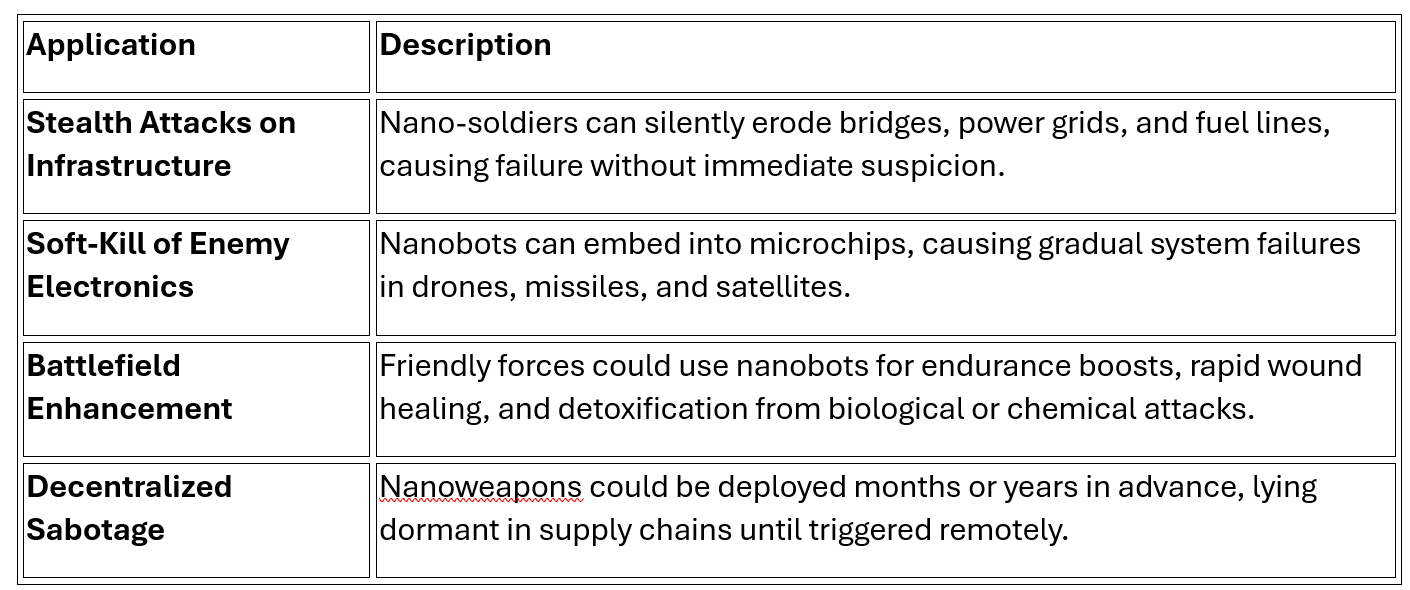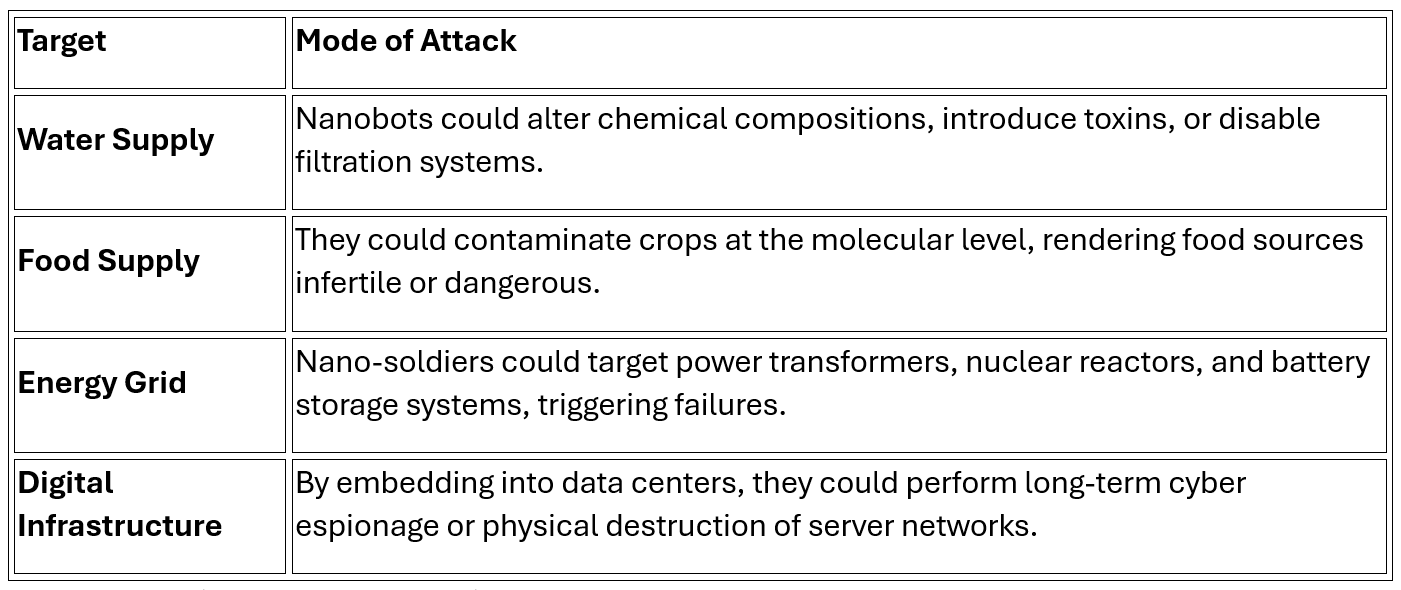The Rise of Invisible Wars
Nanoweaponry & Self-Replicating Nano-Soldiers
Nanoweaponry is an emerging area of advanced warfare where nanoscale machines—designed for stealth, sabotage, and autonomous replication—could disrupt infrastructure, weapon systems, and even biological targets at an unprecedented level. If realized, self-replicating nano-soldiers could change warfare by making attacks almost impossible to detect and defend against.
1. What are Self-Replicating Nano-Soldiers?
Self-replicating nano-soldiers are nanoscale autonomous machines (or molecular robots) capable of infiltrating systems, carrying out targeted sabotage, and reproducing using available materials. These microscopic entities can break down key materials, disable electronics, or even attach to biological organisms to alter behavior or cause harm. Their ability to self-replicate makes them difficult to contain, as they can multiply using local resources, spreading undetected through air, water, or digital networks.
2. Key Capabilities of Nanoweaponry
A. Stealth & Infiltration
Because of their nanoscale size, these weapons can bypass conventional sensors, blending into dust, water, or biological particles. They can disguise themselves as naturally occurring biological entities such as proteins or harmless environmental particles, allowing them to evade detection. Their infiltration capabilities make them ideal for long-term reconnaissance or silent pre-attack positioning.
B. Infrastructure Sabotage
Nano-soldiers can break down key structural materials like concrete, metals, and composites through precisely engineered chemical reactions. When embedded in electronic systems, they can create short circuits, disrupt power flows, or destroy sensitive semiconductor components. Additionally, by interfering with radio signals and communication networks, they can cripple military coordination and infrastructure without direct physical destruction.
C. Bio-Nanoweaponry (Targeting Humans)
Nanobots could be designed to interface with neurons, altering cognitive functions or degrading performance. They may mimic harmless molecules but trigger overactive immune responses, leading to unpredictable physiological effects. By carrying microscopic payloads of toxins, they could deliver precision attacks that activate only under specific conditions, such as a target’s DNA markers or biochemical profile.
D. Self-Replication & Evolution
Self-replicating nanoweapons can construct additional units by extracting materials from their surroundings, adapting their design through AI-driven feedback mechanisms. They can evolve by altering their molecular structure based on environmental changes, making them highly resilient. To prevent uncontrollable spread, they could be programmed with kill-switch mechanisms or specific activation triggers that limit their replication.
3. Deployment Scenarios
A. Military Use Cases
B. Civilian Infrastructure Attacks
C. Asymmetric Warfare & Terrorism
Nanoweaponry could be used for targeted assassinations by deploying self-replicating nanobots that infiltrate a target’s body through the air, water, or direct injection. In the realm of mass psychological operations, nanotechnology could manipulate neurochemicals in populations, inducing heightened fear, paranoia, or altered cognitive functions. For stealth operations, self-disassembling nanobots could execute their mission and dissolve afterward, leaving no trace of their actions.
4. Countermeasures & Defence Against Nanoweaponry
A. Early Detection & Containment
One of the first lines of defence is the development of nanoscale sensors that can identify the presence of foreign nanobots. Smart dust networks—microscopic surveillance particles spread across key locations—can detect and analyze anomalies in their surroundings, helping to locate hidden nano-agents.
B. Defensive Nano-Systems
To counteract nano-sabotage, nations may deploy "hunter-killer" nanobots, designed to detect and neutralize enemy nano-agents before they cause damage. Self-healing infrastructure could incorporate nanotechnology capable of repairing materials, closing electronic circuits, or neutralizing unwanted molecular intruders before they take effect.
C. Regulatory & Ethical Controls
Given the risks, global regulations and treaties may be needed to prevent the development and misuse of nanoweapons, similar to existing bans on biological and chemical weapons. Additionally, digital "kill switch" protocols could be built into all nanotechnology to ensure that any unauthorized or runaway replication can be remotely shut down before it spreads uncontrollably.
5. Future Projections & Long-Term Implications
A. The Rise of Invisible Wars
Nanoweaponry could lead to an era where conflicts are no longer fought with tanks and missiles but through unseen attacks on infrastructure, economies, and populations. A nation’s economy might collapse due to imperceptible failures in key industries, and political instability could be engineered through targeted attacks on communication systems, health networks, and food supplies—all without conventional military action.
B. The End of Traditional Deterrence
If nanoweapons become capable of disabling nuclear facilities or disarming missile systems before they are launched, the doctrine of nuclear deterrence may no longer apply. Nations that develop advanced nano-surveillance and AI-driven counter-nanoweapons will dominate global security. Traditional military superiority could become obsolete if microscopic attacks prove more effective than large-scale conflicts.
C. Existential Risks (Gray Goo & Uncontrolled Replication)
One of the greatest risks of self-replicating nanoweaponry is the "Gray Goo" scenario, where nanobots multiply uncontrollably, consuming all available resources to sustain their replication. If AI-driven nanowarfare is not properly contained, there is the possibility that self-optimizing nanoweapons could evolve in ways their creators did not intend, leading to large-scale destruction beyond human control.
6. Will Nanoweaponry Become the Ultimate Weapon?
Nanoweapons have the potential to become the most powerful and uncontrollable form of warfare ever developed. If a nation masters self-replicating nano-soldiers before adequate countermeasures are in place, it could hold unparalleled strategic dominance. However, strong global regulations, AI control mechanisms, and counter-nanotech measures may be the only way to prevent their misuse. Whether nanoweapons remain a covert tool of superpowers or escalate into an existential global threat will depend on how they are developed, regulated, and defended against in the coming decades.
As of March 2, 2025, self-replicating nano-soldiers for military use remain a theoretical concept, with current nanotechnology focused on more immediate applications like enhanced materials and sensors. However, the trajectory suggests potential future developments that could revolutionize warfare, necessitating proactive countermeasures and ethical frameworks. Military strategists and policymakers should invest in detection and neutralization research, foster international cooperation, and establish regulations to mitigate proliferation risks and ethical concerns.
Key Citations
Military Nanotechnology & Arms Control – IDU Repository
Regulating Weaponized Nanotechnology – UGA Law Digital Commons
DNA nanobots can exponentially self-replicate New Scientist article
Self-replicating nanobots security concerns Network World article
Exponetially self-replicating DNA nanobots are now a thing Interesting Engineering article
Nanotechnology Future military environmental health considerations ScienceDirect article
Nanotechnology in Combat Casualty Care State of the Art HDIAC webinar




